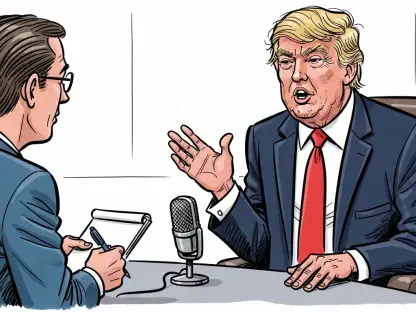Donald Gainsborough, a renowned political savant, has long been a guiding force in shaping policy and legislation. His leadership at Government Curated provides him with deep insights into the intricacies of political maneuvering and fiscal strategies that affect the nation. Today, we delve into the pressing issue of the U.S. debt ceiling and explore the potential economic and political ramifications if Congress does not act promptly.
What are the key reasons for Treasury Secretary Scott Bessent’s urgency in raising the debt ceiling by mid-July?
Secretary Bessent’s call to raise the debt ceiling by mid-July stems from a looming threat of the U.S. government defaulting on its debts, a scenario that could severely damage the country’s credit standing and overall financial stability. With the treasury exploring extraordinary measures that exhaust by August, and Congress scheduled for recess, the urgency is to preempt a shutdown of the federal apparatus, preserving the nation’s financial health and creditworthiness.
Can you explain the potential consequences if Congress doesn’t act on the debt limit before it goes into recess in August?
If Congress fails to raise or suspend the debt limit before recess, the government risks running out of operational funds. This could lead to substantial increases in borrowing costs, a downgrade in the nation’s credit rating, and heightened volatility in financial markets. The confidence of businesses and consumers would be shaken, potentially disrupting economic growth and prompting an urgent need for fiscal intervention.
What are “extraordinary measures,” and how do they help the government manage cash flow until the debt limit is addressed?
Extraordinary measures are strategies employed by the Treasury to free up cash, thus ensuring the government continues to meet its obligations without surpassing the debt ceiling. These measures include halting the issuance of certain debt securities and redeeming investments held by federal funds. While effective temporarily, they only delay the inevitable need to raise the ceiling, making timely congressional action crucial.
How do Republicans plan to use budget reconciliation to raise the debt ceiling without Democratic support?
The Republican strategy involves using budget reconciliation to pass debt ceiling legislation, a procedural tool allowing for expedited passage with a simple majority, thus bypassing Democratic filibusters. This gives Republicans the leverage to align debt ceiling adjustments with wider fiscal goals, free from democratic concessions, and helps advance their agenda.
What might be the challenges or divisions among Republicans regarding raising the debt ceiling through budget reconciliation?
Internal divisions could arise as Republicans debate the long-term fiscal implications of increasing the debt ceiling. Some faction members might resist further debt expansion without accompanying spending cuts, complicating consensus-building. Balancing differing priorities could delay the reconciliation process because achieving a unified stance might be necessary for effective execution.
Reflecting on past experiences, why is it risky to wait until the last minute to address the debt limit?
Historically, the delay in addressing the debt limit has stirred financial instability, causing increased borrowing costs and aggressive market fluctuations in response to uncertainty. These postponements lead to rushed negotiations and possibly unfavorable deals, impacting governmental operations and undermining international confidence in America’s economic governance.
What were the main elements of the bipartisan bill in 2023 that temporarily resolved the debt ceiling issue?
The 2023 bipartisan bill that eased debt ceiling pressures included provisions to suspend the limit until early 2025. It resulted from cross-party cooperation to avoid default threats, coupling debt suspension with agreed limits on federal spending. This compromise embodied short-term stability but required a revisit to fiscal policies to address long-term obligations.
How did the professional assessment from the Treasury Borrowing Advisory Committee underscore risks related to the debt limit?
The Treasury Borrowing Advisory Committee highlighted risks such as increased market volatility, elevated borrowing costs, and weakened financial resilience – all consequences of delayed action on the debt ceiling. Their expertise underlined the urgency of timely adjustments to preserve U.S. financial strength and maintain global economic confidence.
How does the debt limit affect the Treasury Department’s ability to meet the country’s financial obligations?
The debt limit constrains the Treasury’s capacity to issue new debt, restricting funds necessary for government operations. As obligations like interest payments and federal salaries demand consistent coverage, the ceiling’s rigidity can halt essential disbursements, risking default and eroding trust in the government’s fiscal management.
From previous experiences, how have negotiations over the debt limit impacted relationships between political parties?
Negotiations over the debt limit have historically heightened partisan tensions, often forcing parties into stand-offs that challenge cooperation. These strains can shape legislative priorities and disrupt ongoing diplomatic relations as bargaining cites fiscal leverage points, culminating in compromises that may polarize legislative alignments and agendas.
Could you elaborate on the downgrade of the nation’s credit rating mentioned in the context of past debt limit negotiations?
Past debt limit disputes have resulted in reduced credit ratings when prolonged uncertainties led to perceived financial vulnerabilities. Downgrades reflect diminished confidence in the government’s creditworthiness, increasing borrowing costs, undermining economic strength, and signaling fiscal instability both domestically and internationally.
What strategies can Congress employ to ensure the debt ceiling is effectively managed without last-minute rushes?
Congress can implement proactive scheduling to ensure early review and adjustment plans for the debt ceiling, encouraging bipartisan cooperation well ahead of deadlines. This encompasses aligning short-term fiscal goals with long-term strategies, avoiding crisis-driven decision-making, and enhancing legislative transparency to mitigate rushed outcomes.
How can the government ensure that business and consumer confidence are not negatively impacted during debt limit discussions?
The government can maintain business and consumer confidence by delivering clear communication about fiscal strategies and ensuring transparency in debt negotiations. Instituting safeguards like automated debt adjustments when approaching ceilings will reassure involved entities, fostering stability even amidst political debate.
Do you have any advice for our readers?
Readers should remain informed about fiscal policies and understand how political decisions impact economic conditions. Knowledge empowers informed advocacy, urging leaders toward prudent governance, and cultivating awareness of how economic strategies influence personal and national financial outcomes.









